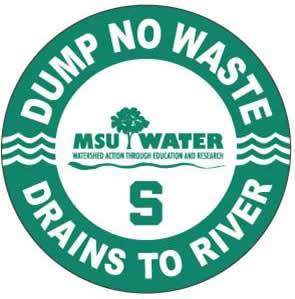Water Protection
Sanitary Drain Disposal
-
MSU Sanitary Drain Disposal Overview
Michigan State University and the City of East Lansing use a sanitary sewer system to convey water from campus buildings, laboratories, and residence halls to the wastewater treatment plant (WWTP), where it is treated before being discharged to the Red Cedar River. The WWTP is designed to treat domestic sanitary wastewater, and it does not treat industrial/toxic pollutants. If any of the products sent down the drain are unable to be removed by the WWTP, they are then discharged directly to the river. Not only do these products harm the aquatic environment, but their discharge can also result in penalties and fines from both the State of Michigan and the Federal Environmental Protection Agency.
-
Solutions not acceptable for sink/sewer disposal
Laboratories have the responsibility to dispose of many chemicals and polluting substances that are used every day. That is why, generally, laboratories are prohibited from disposing of any of these substances down a drain and must contact EHS for proper disposal. Laboratory discharges of the following types of materials are prohibited:
- Metal-containing wastes
- Reactive wastes (cyanides, sulfide, etc.)
- Solvents (halogenated and non-halogenated)
- Unused or outdated chemicals
- Oxidizers (perchloric acid, chromic acid, etc.)
- Sludges or viscous materials
- Solids or insoluble substances
- Corrosive wastes
- Biohazardous wastes (including animal waste)
- Radioactive wastes
- Formaldehyde
- Petroleum oil or grease
- PCBs
- Liquid Industrial by-products (antifreeze, pesticides, etc.)
- Phenols
- Ammonia
- Known and Probable Carcinogens
EHS Chemical Hygiene Training provides additional training and guidance on drain disposal and chemical restrictions. -
Solutions acceptable for sewer/sink disposal
Contact EHS directly for guidance regarding substances that may be acceptable for discharge to the sanitary drain. The following materials are not considered toxic and are generally safe for sanitary sewer disposal:
- Saline Solutions
- Buffer Solutions (pH range 5.5 – 10.0)
- Soapy Water Solutions
- Blood with Deactivated Cultures
- Rinse Water Solutions (from non-hazardous lab glassware)
- Glucose Solutions
- Food Additive Solutions
- Bleach Solutions (10% or less)
- Watercolor Dye Solutions
- Disinfected Biohazardous Waste (body fluids)
Storm Water Drains
-
MSU Storm Drain System Overview
Michigan State University has hundreds of outdoor storm drains that convey water directly to the Red Cedar River. This separate drainage system is not connected to the sanitary sewer system, and the water is not treated by any wastewater treatment plant before it flows to the river. No materials other than precipitation (including rainwater and snow melt) and groundwater are allowed to enter the storm drains. Because MSU is regulated by a Municipal Storm Sewer System permit from the State of Michigan, extra care must be taken to ensure that the precipitation doesn’t transport surface pollutants with it to the river. Dumping of any materials in a storm drain is strictly forbidden.

Ground Water
To protect our groundwater, which is the sole source of drinking water in the Greater Lansing area, MSU has developed a Wellhead Protection Program.
Regulations, Permits
-
Regulatory Background
The Clean Water Act (CWA) is the primary Federal statute regulating the protection of the nation's waters. CWA was enacted in 1972 in response to nationwide water pollution issues and was amended in 1977 and 1987. Section 311 of CWA was amended by the Oil Pollution Act (OPA) of 1990, which has its own separate regulation and enforcement scheme. CWA established national programs for the prevention, reduction, and elimination of pollution in navigable water and groundwater. It also sets up a water quality standards program and required permits for discharge and treatment of wastewater and storm water.
-
MSU's Permits
MSU has a MS4 permit issued by EGLE. Elements include an Illicit Discharge Elimination Plan (IDEP)/Public Education Plan (PEP) program. An MS4 is a system of drainage (including roads, storm drains, pipes and ditches, etc.) that is not a combined sewer or part of a sewage treatment plant. During wet weather, pollutants are transported through MS4s to local waterbodies. The goal of this permit is to reduce the discharge of pollutants to surface waters of the state. Under the permit, post-construction storm water run-off from all new and redevelopment projects must meet specified storm water discharge criteria as defined in the MSU Storm water design standards. This permit also covers regular housekeeping activities and best management practices that must be employed around campus to prevent any contamination from reaching the storm drains. A campus-wide storm water committee oversees MSU’s MS4 General Watershed Permit.
MSU maintains a Spill Prevention, Control and Countermeasure (SPCC) Plan as required by the United States Environmental Protection Agency (US EPA) to prevent any discharge of petroleum material into or upon navigable waters of the United States. The SPCC plan is reviewed annually and amended based on design or construction changes where petroleum products are stored. Copies of the SPCC plan are maintained at various locations on campus.
- Regulatory References

